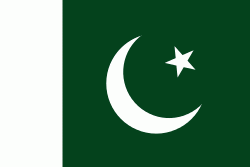Charsadda
Chārsadda (چارسده; ; ; ) is a town and headquarters of Charsadda District, in the Khyber Pakhtunkhwa province of Pakistan. It is the eighty fifth-largest city of Pakistan, according to 2017 census. Located in the Valley of Peshawar, Charsadda lies about 29 km from the provincial capital of Peshawar at an altitude of 276 m. The total area of Charsadda District measures about 996 square Km. The district is geographically organized into two primary parts: Hashtnagar (Pashto: Ashnaghar) and Do Aaba (Pashto: Duaba).
The earliest archaeological deposits recovered at Charsadda, in Bala Hisar, are dated to ca. 1400 BCE, when a small community was established on a low natural mound of clay above the floodplain of the Kabul and Swat rivers, constructing structures of timber posts slotted into postholes, in association with ceramic sherds and ash. Subsequent periods indicate that more permanent structures were built at Charsadda, including stone-lined pits. Between the 14th century BCE and the 6th century BCE, when an Achaemenid presence is represented at the site (see below), the inhabitants of Charsadda developed an iron-working industry and used ceramics that are typical for this period in the Vale of Peshawar, Swat and Dir. The later history of Charsadda can be traced back to the 6th century BCE. It was the capital of Gandhara from the 6th century BCE to the 2nd century CE. The ancient name of Charsadda was Pushkalavati.The city hosts the ruins of what was once the ancient Gandharan capital city of Pushkalavati (meaning Lotus City in Sanskrit), and The father of Sanskrit grammar, Pāṇini was from this area and lived around 4th century BCE. Many invaders have ruled over this region during different times of history. These include the Durrani Empire, Alexander the Great's Macedonians, the Mauryas, the Greco-Bactrians, the Indo-Greeks, the Indo-Scythians, the Indo-Parthians, the Kushans, the Huns, the Turks, the Guptas. Charsadda is contiguous to the town of Prang; and these two places were identified by Alexander Cunningham with the ancient Pushkalāvati, capital of the region at the time of Alexander's invasion, and transliterated as Peukelaus or Peukelaotis by the Greek historians. Its chieftain (Astes), according to Arrian, was killed in defence of one of his strongholds after a prolonged siege by Hephaistion. Ptolemy fixes its site upon the eastern bank of the Suastene or Swat. The region was later conquered by Chandragupta Maurya from the Macedonian straps.
The earliest archaeological deposits recovered at Charsadda, in Bala Hisar, are dated to ca. 1400 BCE, when a small community was established on a low natural mound of clay above the floodplain of the Kabul and Swat rivers, constructing structures of timber posts slotted into postholes, in association with ceramic sherds and ash. Subsequent periods indicate that more permanent structures were built at Charsadda, including stone-lined pits. Between the 14th century BCE and the 6th century BCE, when an Achaemenid presence is represented at the site (see below), the inhabitants of Charsadda developed an iron-working industry and used ceramics that are typical for this period in the Vale of Peshawar, Swat and Dir. The later history of Charsadda can be traced back to the 6th century BCE. It was the capital of Gandhara from the 6th century BCE to the 2nd century CE. The ancient name of Charsadda was Pushkalavati.The city hosts the ruins of what was once the ancient Gandharan capital city of Pushkalavati (meaning Lotus City in Sanskrit), and The father of Sanskrit grammar, Pāṇini was from this area and lived around 4th century BCE. Many invaders have ruled over this region during different times of history. These include the Durrani Empire, Alexander the Great's Macedonians, the Mauryas, the Greco-Bactrians, the Indo-Greeks, the Indo-Scythians, the Indo-Parthians, the Kushans, the Huns, the Turks, the Guptas. Charsadda is contiguous to the town of Prang; and these two places were identified by Alexander Cunningham with the ancient Pushkalāvati, capital of the region at the time of Alexander's invasion, and transliterated as Peukelaus or Peukelaotis by the Greek historians. Its chieftain (Astes), according to Arrian, was killed in defence of one of his strongholds after a prolonged siege by Hephaistion. Ptolemy fixes its site upon the eastern bank of the Suastene or Swat. The region was later conquered by Chandragupta Maurya from the Macedonian straps.
Map - Charsadda
Map
Country - Pakistan
 |
 |
| Flag of Pakistan | |
Pakistan is the site of several ancient cultures, including the 8,500-year-old Neolithic site of Mehrgarh in Balochistan, the Indus Valley civilisation of the Bronze Age, the most extensive of the civilisations of the Afro-Eurasia, and the ancient Gandhara civilization. The region that comprises the modern state of Pakistan was the realm of multiple empires and dynasties, including the Achaemenid; briefly that of Alexander the Great; the Seleucid, the Maurya, the Kushan, the Gupta; the Umayyad Caliphate in its southern regions, the Hindu Shahis, the Ghaznavids, the Delhi Sultanate, the Mughals, the Durranis, the Omani Empire, the Sikh Empire, British East India Company rule, and most recently, the British Indian Empire from 1858 to 1947.
Currency / Language
| ISO | Currency | Symbol | Significant figures |
|---|---|---|---|
| PKR | Pakistani rupee | ₨ | 2 |
| ISO | Language |
|---|---|
| EN | English language |
| PA | Panjabi language |
| PS | Pashto language |
| SD | Sindhi language |
| UR | Urdu |















